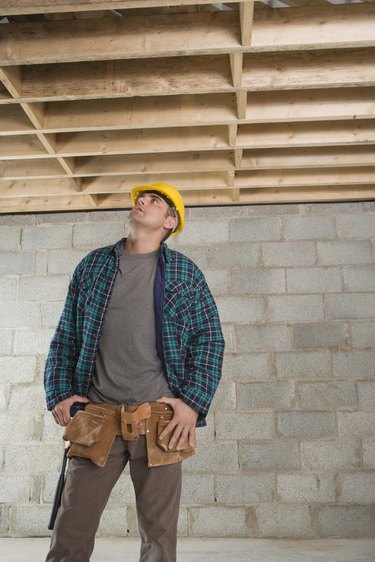
If all houses were single-level homes without stairways, skylights or lofts, floor and ceiling joists could run from one end to the other without interruption. However, most homes, if they're not patio homes, have stairways or an attic entrances, and these elements require special framing within the floor or ceiling joists. A trimmer joist plays an important role in supporting load when nearby joists must be cut to allow for a stairway or another framed opening in the joist pattern.
Joist Properties
Video of the Day
Floor and ceiling joist systems offer support for walls and roof loads. Joists are the horizontal framing members that rest upon the structure's vertical supports, such as foundation or basement walls, load bearing walls and beams. Architects design joists to support and disperse the weight of the structure evenly to keep from concentrating the load on any one point.
Video of the Day
Cutting Joists
Cutting through structural joists is a no-no, unless an engineer or an architect made provisions for safely transferring the load to other structural supports. For example, if you cut two joists to frame an opening in your floor for a dumbwaiter, the joists on either side of the ones you cut will now have to bear the load of the cut joists, which are no longer structurally sound.
Running Headers
Once you cut through joists, the cut ends no longer have support and will sag. To stabilize the cut joists, you'll have to install headers that run between the solid joists on either side of the cut joists. Headers run perpendicular to the direction of the joists, and you will attach the headers to the ends of the cut joists for support. You'll need headers on both sides of the new opening. When installed, you'll have a framed rectangle in the floor. An engineer may call for double headers, and if so, you'll run another header flush with the first header, screwing them together and attaching them to the solid joists on either end.
Trimmer Joists
Once you've installed the headers, you've transferred the load the cut joists were originally carrying to the adjacent solid joists, but this may be too much weight for these single joists to carry. The remedy is to beef-up those single joists by running additional, full-length joists right beside them. These new supporting joists are trimmer joists; they must be the same length as the original joists, and they must rest on the same beam or load bearing wall. Trimmer joists attach to the original uncut joists to double their load-bearing ability.